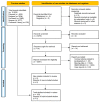Corneal Edema after Cataract Surgery
- PMID: 37959216
- PMCID: PMC10647590
- DOI: 10.3390/jcm12216751
Corneal Edema after Cataract Surgery
Abstract
This systematic review investigates the prevalence and underlying causes of corneal edema following cataract surgery employing manual phacoemulsification. A comprehensive search encompassing databases such as PubMed, Embase, ProQuest, Cochrane Library, and Scopus was conducted, focusing on variables encompassing cataract surgery and corneal edema. Two independent reviewers systematically extracted pertinent data from 103 articles, consisting of 62 theoretical studies and 41 clinical trials. These studies delved into various aspects related to corneal edema after cataract surgery, including endothelial cell loss, pachymetry measurements, visual performance, surgical techniques, supplies, medications, and assessments of endothelial and epithelial barriers. This review, encompassing an extensive analysis of 3060 records, revealed significant correlations between corneal edema and endothelial cell loss during phacoemulsification surgery. Factors such as patient age, cataract grade, and mechanical stress were identified as contributors to endothelial cell loss. Furthermore, pachymetry and optical coherence tomography emerged as valuable diagnostic tools for assessing corneal edema. In conclusion, this systematic review underscores the link between corneal edema and endothelial cell loss in manual phacoemulsification cataract surgery. It highlights the relevance of factors like patient demographics and diagnostic modalities. However, further research is essential to unravel the complexities of refractive changes and the underlying mechanisms.
Keywords: cataract surgery; corneal edema; optical coherence tomography; pachymetry; refractive changes; visual performance.
Conflict of interest statement
The funding organizations had no role in the design or conduct of this research. None of the authors have financial disclosures related to this manuscript.
Figures
Similar articles
-
Correlation Between Postoperative Central Corneal Thickness and Endothelial Damage After Cataract Surgery by Phacoemulsification.Cornea. 2018 May;37(5):587-590. doi: 10.1097/ICO.0000000000001502. Cornea. 2018. PMID: 29303887
-
Corneal edema after phacoemulsification.Indian J Ophthalmol. 2017 Dec;65(12):1381-1389. doi: 10.4103/ijo.IJO_871_17. Indian J Ophthalmol. 2017. PMID: 29208818 Free PMC article. Review.
-
Correlation between early corneal edema and endothelial cell loss after phacoemulsification cataract surgery.Front Med (Lausanne). 2025 May 29;12:1562717. doi: 10.3389/fmed.2025.1562717. eCollection 2025. Front Med (Lausanne). 2025. PMID: 40510852 Free PMC article.
-
Analysis of influencing factors of corneal edema after phacoemulsification for diabetic cataract.Cell Mol Biol (Noisy-le-grand). 2023 Apr 30;69(4):164-171. doi: 10.14715/cmb/2023.69.4.26. Cell Mol Biol (Noisy-le-grand). 2023. PMID: 37329530
-
Toric intraocular lens versus limbal relaxing incisions for corneal astigmatism after phacoemulsification.Cochrane Database Syst Rev. 2019 Dec 17;12(12):CD012801. doi: 10.1002/14651858.CD012801.pub2. Cochrane Database Syst Rev. 2019. PMID: 31845757 Free PMC article.
Cited by
-
The Duration of Cataract Surgery and the Change in Postoperative Dry Eye Disease Parameters: A Retrospective Cohort Study.Diagnostics (Basel). 2025 Jan 30;15(3):330. doi: 10.3390/diagnostics15030330. Diagnostics (Basel). 2025. PMID: 39941260 Free PMC article.
-
Expression and clinical significance of IGF-1 and PDGF in aqueous humor and serum of diabetic patients with visually significant cataract.Cytotechnology. 2025 Jun;77(3):94. doi: 10.1007/s10616-025-00754-2. Epub 2025 Apr 29. Cytotechnology. 2025. PMID: 40313509
-
Phacoemulsification Techniques and Their Effects on Corneal Endothelial Cells and Visual Acuity: A Review of "Direct-Chop" and "Stop-and-Chop" Approaches Under Topical Anesthesia.Cureus. 2024 Aug 10;16(8):e66587. doi: 10.7759/cureus.66587. eCollection 2024 Aug. Cureus. 2024. PMID: 39258086 Free PMC article. Review.
-
The refractive accuracy between topographic keratometry and biometric keratometry for extended depth-of-focus intraocular lens implantation.Int J Med Sci. 2024 Nov 4;21(15):2912-2918. doi: 10.7150/ijms.99907. eCollection 2024. Int J Med Sci. 2024. PMID: 39628690 Free PMC article.
-
Elevated Inflammatory Cytokines Persist in the Aqueous Humor Years After Cataract Surgery.Invest Ophthalmol Vis Sci. 2025 Apr 1;66(4):12. doi: 10.1167/iovs.66.4.12. Invest Ophthalmol Vis Sci. 2025. PMID: 40183733 Free PMC article.
References
-
- Hess R.F., Carney L.G. Vision through an abnormal cornea: A pilot study of the relationship between visual loss from corneal distortion, corneal edema, keratoconus, and some allied corneal pathology. Investig. Ophthalmol. Vis. Sci. 1979;18:476–483. - PubMed
Publication types
LinkOut - more resources
Full Text Sources


